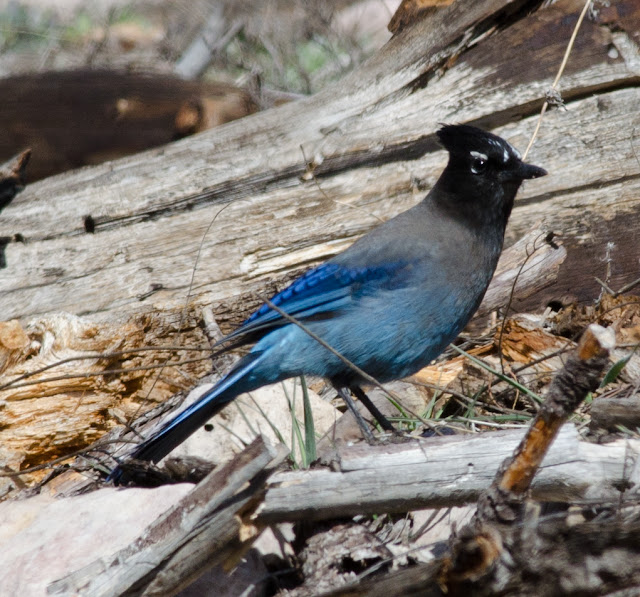After spending few days in the southern part of Arizona, I traveled north to the towns of Heber/Overgaard and the surrounding area which is above the Mogollon Rim and at an elevation around 7000' and higher. Quite a different landscape and much cooler temperatures. Included in this area is Black Canyon Lake, which has been a very nice spot for me to go birding. Last fall, this lake was where I discovered a Pacific Loon, which was apparently the first record of that species in Navajo County. The entire area is very under birded and I would encourage other avian enthusiasts to visit the area when they get a chance.
My title of this post, already suggests the color blue, so I should probably start off this post with my collection of birds decked out in the color blue. The first bird is the bluest of blue; the Mountain Bluebird. So if you like the color blue, then you have to ♥ this bird. Then if you like your 'blue' birds a bit larger and with a crest and a little bit of black highlights thrown in, then maybe your preference is the Stellar's Jay. And to top it off, we have a third 'blue' bird, which is the Western Bluebird and one of the most common birds to be found in this area. And for this species I have photos of both a male and a female.
Mountain Bluebird
Mountain Bluebird
Steller's Jay
Western Bluebird - Male
Western Bluebird - Female
After seeing the Yellow-eyed Junco on Mt Lemmon, the northern areas is the place to find the Dark-eyed Junco. This bird was the most numerous of all the birds I encountered above the Rim and most of them were the Gray-headed subspecies, but I did see 1 Oregon type.
Dark-eyed Junco
A rather unusual bird that I found at Black Canyon Lake was a male Vermilion Flycatcher. The species itself is not rare by any means in Arizona, but they are extremely rare at such a high elevation of about 7100'. It was very cold on the first day I visited this place and the cold must have slowed down this one's molt, as it has not completely molted into the adult plumage.
Vermilion Flycatcher
Also found lots of nuthatches, especially Pygmy and White-breasted with the Pygmy being the most numerous. They are dynamic little acrobats in the trees.
Pygmy Nuthatch
Pygmy Nuthatch
White-breasted Nuthatch
Will round out this post with another beautiful bird, Grace's Warbler. This is a bird that I had only seen twice before this year. Now this year I have seen several and after this trip up north I can honestly say I have seen dozens of them. They were singing from the pines at just about every place I stopped. Still not easy to photograph, like most warblers are, but always a pleasure to find and enjoy.
Grace's Warbler
Grace's Warbler
Grace's Warbler
Will follow up with one more post from this area and then back to basic birding in the valley again.














Beautiful photos Gordon. Contrary to the mood often associated with the opening color scheme, they did NOT make me feel blue : )
ReplyDeleteGreat images! I am puzzling over seeing a blue colored bird in my area in Maricopa. The housing area sits on the edge of reservation land. However, the blue birds I have seen today in a cluster of 6-- are a brilliant electric blue depending on angle of flight and the stomach area is grey not red, and no darker feathers in wing tip and tail tip.
ReplyDeleteGreat images! I am puzzling over seeing a blue colored bird in my area in Maricopa. The housing area sits on the edge of reservation land. However, the blue birds I have seen today in a cluster of 6-- are a brilliant electric blue depending on angle of flight and the stomach area is grey not red, and no darker feathers in wing tip and tail tip.
ReplyDelete